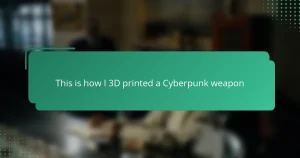Key takeaways
- Science fiction props serve as storytelling tools, making abstract concepts tangible and enhancing audience immersion.
- Material selection is crucial; diverse materials like foam, acrylic, and 3D-printed plastics provide authenticity while being easy to work with.
- Patience and precision are vital in prop building, especially in achieving authentic details and functionality in complex designs.
- Showcasing completed projects fosters community engagement, allowing builders to share their unique interpretations and connect with others who share their passion.

Understanding Science Fiction Props
When I first started exploring science fiction props, I realized they’re far more than just cool gadgets or costumes—they’re storytelling tools that bring entire worlds to life. Have you ever held a prop and felt an instant connection to the story it represents? That’s the magic of these items; they make abstract sci-fi concepts tangible and relatable.
From my experience, understanding these props means appreciating the craftsmanship and imagination behind them. It’s fascinating to see how designers blend futuristic ideas with practical design to create objects that look believable within their fictional universes. This blend inspires me to think critically about how props influence the audience’s immersion.
I often ask myself, what makes a prop iconic? It’s that perfect mixture of detail, functionality, and emotional resonance. When you build or study these props, you start to notice subtle cues that hint at the character’s story or the world’s culture, deepening your appreciation for the art of science fiction itself.

Materials Used for Science Fiction Props
Materials used for science fiction props are surprisingly diverse, shaped by both creativity and practicality. I remember when I first handled a Pip-Boy replica; the mix of plastics and metals gave it an authentic feel, as if it could really survive a post-apocalyptic world. Have you ever wondered how something so futuristic can still look worn and functional? That’s often thanks to thoughtful material choices that balance durability with visual appeal.
In my experience, selecting materials is a delicate dance between realism and ease of crafting. Foam, acrylic, and 3D-printed plastics are staples because they’re lightweight and easy to manipulate, yet they can be painted and weathered to mimic metal or aged electronics. When I built my own Pip-Boy, working with these materials let me experiment freely, knowing I wasn’t risking expensive components but still achieving a convincing final look.
What fascinates me most is how these materials transform simple ideas into objects that tell stories. The texture of a painted foam surface or the subtle sheen of a 3D print can invoke emotions tied to the prop’s fictional history. It’s those little details, grounded in smart material choices, that make science fiction props resonate far beyond their physical form.

Tools Needed for Prop Building
When I started building my Fallout Pip-Boy, I quickly learned that having the right tools makes all the difference. Basic hand tools like hobby knives and files were indispensable for shaping intricate parts. Have you ever tried cutting tiny details without a precision blade? It’s frustrating, and that’s why investing in quality cutting tools pays off.
Beyond the basics, I found a rotary tool to be a game-changer for smoothing edges and drilling small holes. At first, I hesitated to use power tools, but once I gave it a try, the process became faster and more accurate. Safety gear like goggles and masks also became my trusted companions—I can’t stress enough how important it is to protect yourself when sanding or working with fumes.
One surprising addition to my toolkit was a small heat gun. It helped me bend plastic elements to fit the Pip-Boy’s complex curves perfectly. I never expected a heat gun to be so useful in prop building, but it turned out to be essential for achieving that authentic, professional look. Have you ever experimented with heat shaping? It really opens up new possibilities in crafting custom parts.

Step by Step Fallout Pip-Boy Guide
Starting the Fallout Pip-Boy build, I found it crucial to break down the process into manageable steps. Have you ever felt overwhelmed by a complex project? For me, beginning with assembling the base frame helped ground the whole endeavor, turning a daunting task into a satisfying puzzle. This initial step is all about creating a solid foundation that supports every subsequent detail.
Next, I remember carefully layering the electronic components and display elements. It felt like bringing the device to life—much like piecing together a miniature story of the post-apocalyptic world itself. What struck me was how patience mattered more than speed; rushing through wiring or mounting parts often led to frustrating fixes later on.
The final stages were about adding weathering and finishing touches, which truly gave my Pip-Boy its character. Applying worn paint and subtle scratches transformed a simple replica into a prop with a believable history. Have you noticed how those finishing details can make or break authenticity? That’s where I realized the importance of taking my time to replicate the look and feel of a device well-used by a survivor.

Common Challenges in Pip-Boy Building
One challenge I often faced while building my Pip-Boy was getting the scale just right. Have you ever tried fitting complex parts into such a compact design? It’s tricky because even a slight miscalculation can throw off the entire build, making it look less authentic or feel uncomfortable to wear. I remember re-measuring multiple times, learning that precision is absolutely key.
Another hurdle was replicating the intricate details that make the Pip-Boy iconic—the buttons, screens, and vents. It took me countless hours of trial and error, experimenting with different techniques and materials to capture that worn yet high-tech vibe. Sometimes I got frustrated when tiny parts wouldn’t stay put, but pushing through those moments taught me patience and problem-solving.
Lastly, assembling the electronics was a real test of my perseverance. Wiring small components into a coherent system felt overwhelming at first; I wasn’t always sure if the screen or buttons would function as I hoped. Have you ever wondered how to balance aesthetics with actual usability in a prop? Finding that sweet spot made the victory even sweeter when everything finally lit up as intended.

Personal Tips for Building Pip-Boy
One tip I’ve learned is not to rush the painting and weathering process. Have you ever tried to speed through those details only to end up with a finish that looks flat or artificial? Taking the time to layer colors and add subtle wear really brings the Pip-Boy to life, making it feel like a device that’s been through countless adventures with its wearer.
I also found that organizing all my parts before assembly saved me a lot of headaches. When you’re juggling tiny buttons, screens, and hinges, losing track can disrupt your flow and mess with your patience. Laying everything out clearly helped me maintain focus and kept the build enjoyable instead of overwhelming.
Lastly, don’t underestimate the power of testing as you go. I used to worry that constant adjustments would slow me down, but checking the fit and function of parts frequently caught issues early. Isn’t it better to catch a problem before you glue or solder something permanently? That approach saved me both time and frustration in the long run.

Showcasing Completed Pip-Boy Projects
Showcasing completed Pip-Boy projects always feels like sharing a piece of my journey with fellow enthusiasts. When I first revealed my finished build, the mix of pride and relief was overwhelming—after all the late nights and tiny tweaks, seeing it hold together and glow just like in the game was truly rewarding. Have you ever experienced that moment when your hard work suddenly becomes something tangible and real?
What fascinates me most about these showcases is how every Pip-Boy, though inspired by the same design, tells a unique story. Some builders focus on functional electronics, while others nail the weathered, gritty look—each version reflecting personal creativity and technical skill. I often find myself admiring how different interpretations bring out new facets of the device’s personality.
It’s also inspiring to witness how completed projects spark conversations and connections. When I shared pictures of my Pip-Boy online, the flood of questions and shared tips reminded me that prop building is as much about community as it is about craftsmanship. Isn’t it amazing how a single prop can bring people together around a shared passion?


